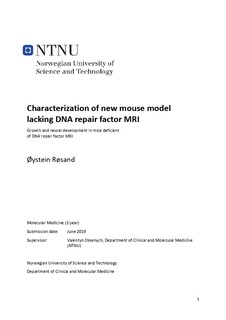| dc.description.abstract | Double-strand breaks (DSBs) are constantly generated in the DNA by endogenous and exogenous agents. In mammalian cells, DSBs activate DNA damage responses (DDRs) to repair the lesions. One major DSB repair pathway is non-homologous end-joining (NHEJ), which is active throughout the cell cycle and is especially required for the homeostasis of post-mitotic neurons in the brain. NHEJ involves a variety of factors; some are essential and evolutionary conserved, while other are accessory and only required for specific types of lesions. To determine the roles of specific NHEJ factors, genetic inactivation of the corresponding NHEJ genes has been established in mice. Previously, several mouse models lacking one or multiple proteins has been generated and characterized. For this project, a mouse model lacking an accessory NHEJ factor named modulator of retroviral infection (MRI) was developed and characterised. The first aim of this project was to investigate the impact of MRI deficiency on growth and neural development in our Mri mouse model. This was done by comparing the body weight and size of Mri-/- and WT mice. To determine the effect of Mri inactivation on neural development, brains from WT and Mri-/- mice were isolated, and neurosphere cultures were established. These cultures were used to compare WT and Mri-/- neural stem progenitor cell (NSPC) proliferation, self-renewal and differentiation. The Mri knockout model was here found to be indistinguishable from WT mice in relation to growth, NSPC self-renewal and differentiation. However, Mri-/- NSPC have impaired proliferation. This suggest that MRI support cellular proliferation during mammalian neurogenesis. The second aim of this project was to investigate genetic interaction between MRI, XLF, PAXX, DNA-PKcs and p53. For this aim, 89 pups were analysed, however, further studies are required to make a solid conclusion. | |
